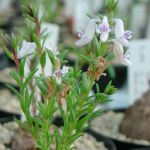| Common Name: |
Nindi |
| Other Names: |
Ninde |
| Botanical Name: |
Aeollanthus gamwelliae |
| Genus: |
Aeolanthus |
| Family: |
Lamiaceae |
| Native Location: |
E African mountains |
| Cultivation: |
Well-drained to dry, sandy soil in sun. |
| Propagation: |
By seed sown in sandy soil mix in spring |
| Harvest: |
Whole plant, or leaves and flowers separately, are distilled for oil. |
| Height: |
1.5m (5ft) |
| Width: |
1m (3ft) |
| Hardiness: |
Min. 15-18°C (59-64°F) |
| Parts Used: |
Whole palan, leaves, flowers, oil. |
| Properties: |
An aromatic herb, rich in essential oils, including geraniol (as in Pelargonium 'Graveolens', see rose geranium). |
| Culinary Uses: |
Leaves are used to flavor soups and salads. |
| Economic Uses: |
Oil from leaves and flowers is used in soaps and perfumes, often as a substitute for palmarosa oil (from Cymbopogon martinii, see palmarosa). |
| Bibliography: |
Encyclopedia of Herbs by Deni Brown Copyright © 1995, 2001 Dorling Kindersley Limites. Pg 104
|

